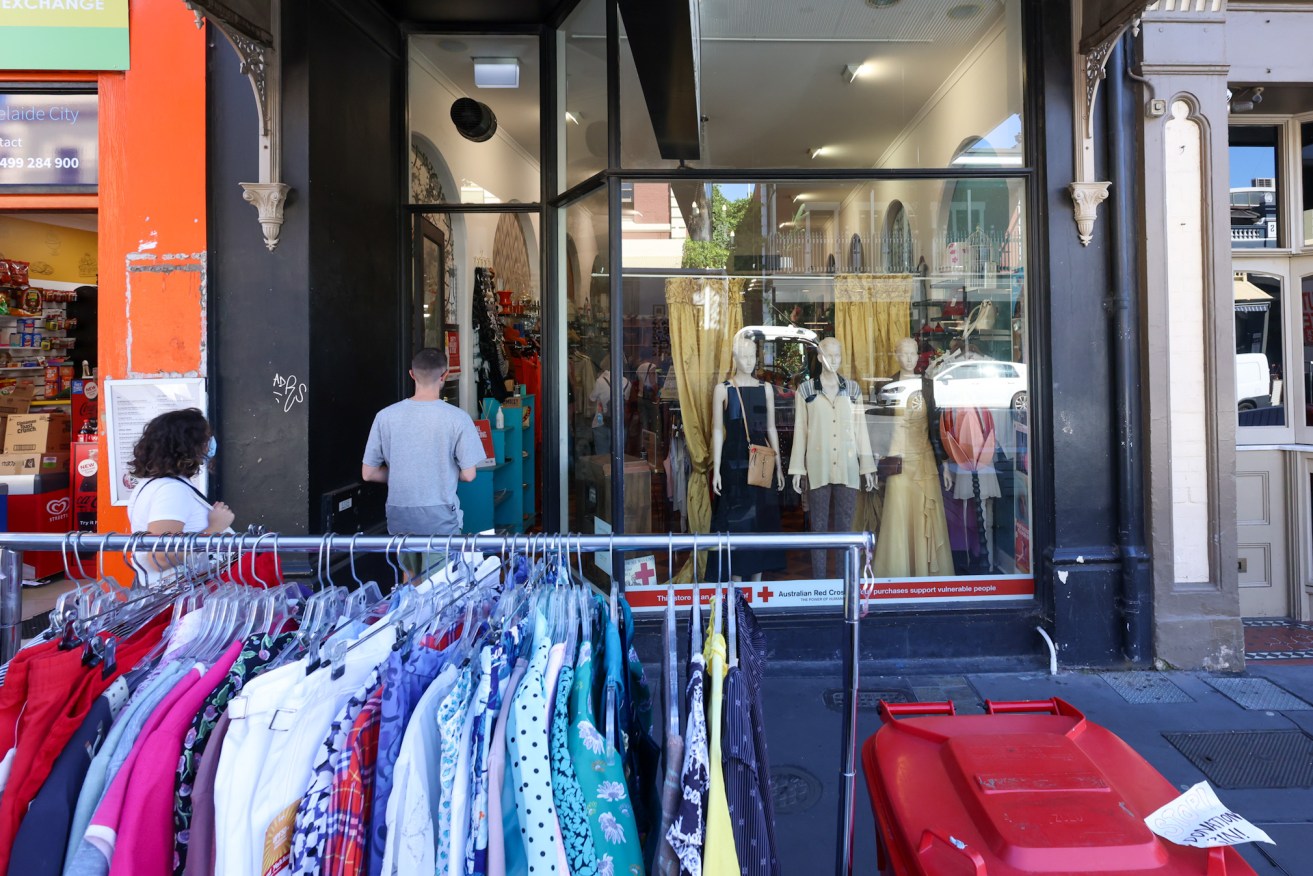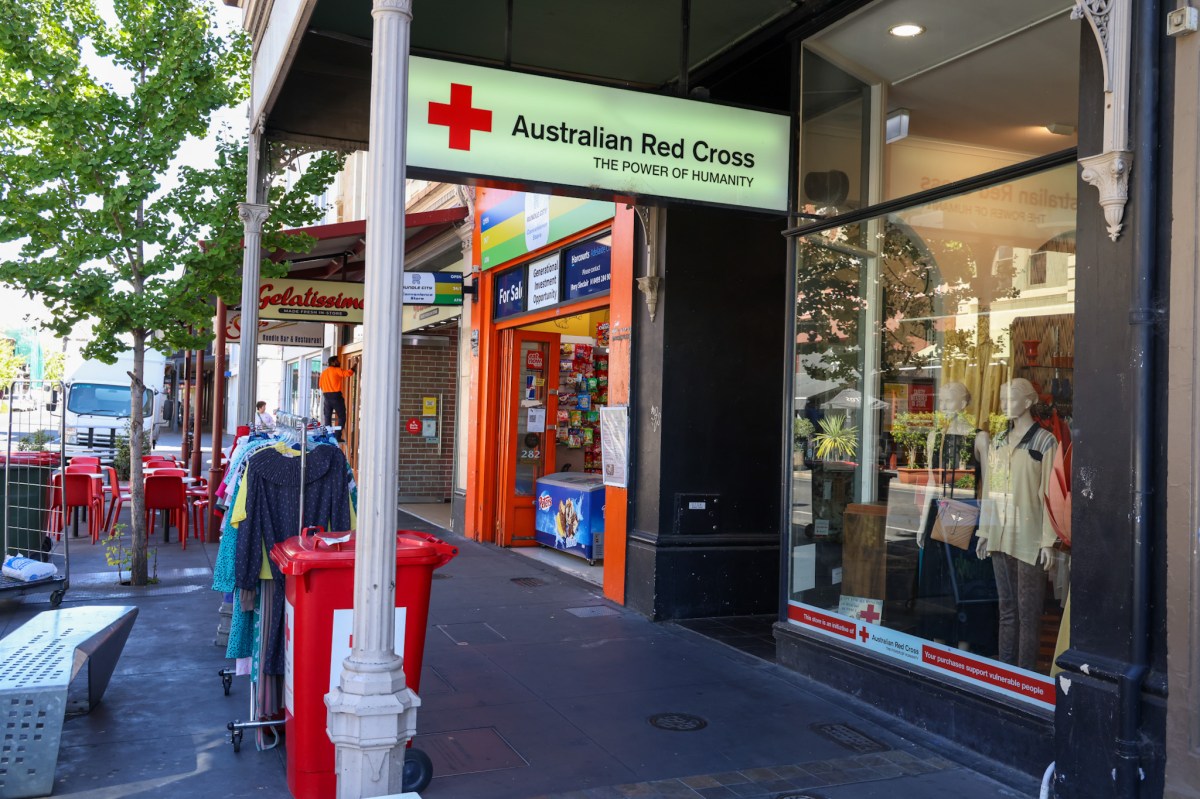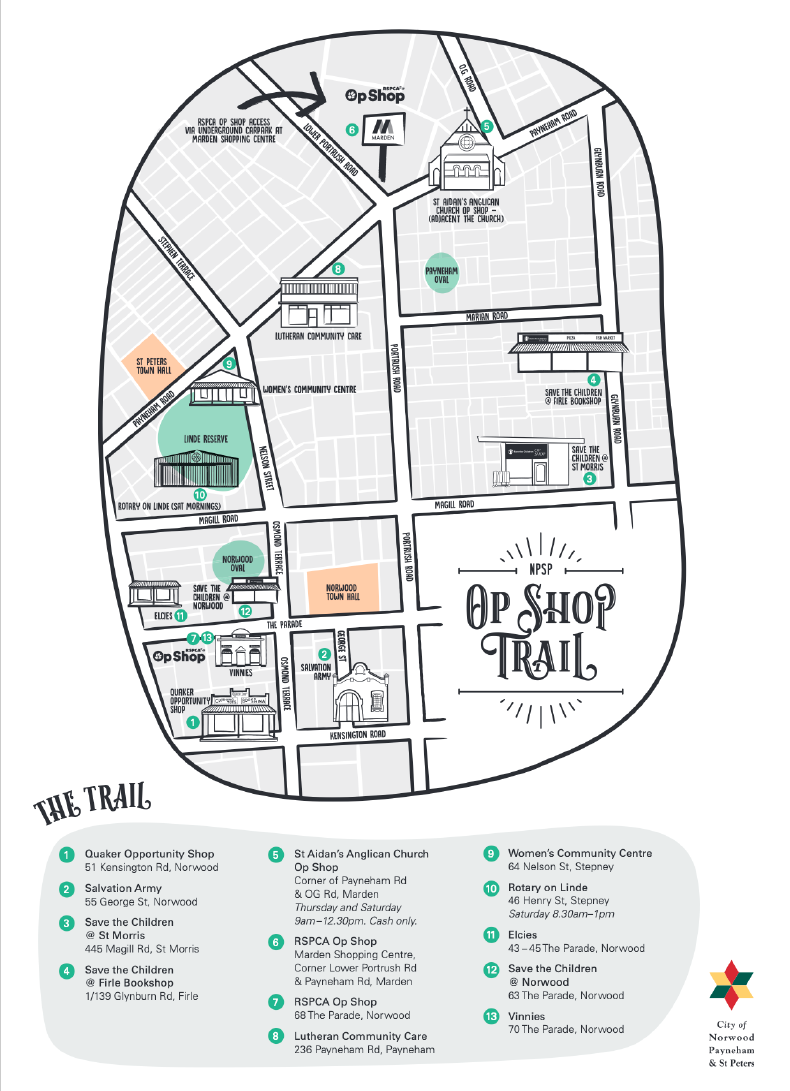Op shops still the bargain pick of retail strips
The egalitarian lure of finding recycled treasures makes op shops a dynamic feature of urban streetscapes, writes Eduardo de la Fuente.

Bargains to be had inside a city op shop. Photo: Tony Lewis/InDaily
There it was sitting on the top shelf of a display cabinet at Salvos in Mt Barker, looking like the cosmos had sent it my way.
I’m referring to an interesting wall plate featuring Mediterranean-cum-Middle Eastern decorative patterns. More importantly, the object had the words “Colonia” (a UNESCO Heritage-listed cobblestoned town on the banks of the River Plate) and “Uruguay” (the country of my birth) emblazoned on it. The back of the plate bore the signature of the ceramicist and a stamp identifying the pottery studio in “Punta del Este” where it had been made.
In over three decades of op shopping In Australia, I had never encountered an object made in “little old” Uruguay before. As such, it gave me great pleasure that it was at a Salvos, which Google Maps told me was 5.1km from where I live. Of course, op shops are all about serendipity and chance encounters. There was the time I bought a suit for $10 in an op shop in Stanthorpe, QLD, which I ended up using for a job interview at the University of Tasmania in Hobart. Or the time I came across a 25-year-old edition of the Melbourne-based journal Meanjin, which contained my first-ever published essay, in an op shop in the Blue Mountains town of Katoomba, NSW.
Needless to say while many objects have entered my life via op shops, some have also departed via the same route. Thus, my op shop finds remind me of where I have lived and what places I have visited; the garbage bags full of clothes dropped off at op shops attesting to past versions of myself.
If op shop “finds” remind us of places with biographical significance, it is important to remember that op shops are themselves places with unique place-qualities. Op shops have distinctive atmospheres, and part of their appeal is that they don’t resemble the more “generic” spaces of mainstream shopping. Op shops can be housed in heritage buildings and feel like they are an upmarket boutique clothing store, or they can be housed in medium-sized factory or warehouse buildings closer in feel to large discount stores.

Photo: Tony Lewis/InDaily
Op shops also feel different because of their display cultures – something that seems to have undergone a significant degree of “professionalisation” in recent years. One display trend that op shops use to good effect is to assemble objects according to colour (i.e. an entire shelf full of blue objects) something which gives op shops a highly organised yet fun quality.
Volunteer staff also play their part in making op shops feel different. Op shop staff are never pushy and leave you free to browse. They tend to confine their interactions with customers to the occasional check-out comment such as “Oh, that’s a good score”.
If op shops are places with a distinct feel, they in turn help to generate interesting street and neighbourhood atmospheres. In 2020, Time Out magazine ranked Marrickville (yes, the Sydney inner-west ‘hipster’ suburb where Albo lives and has his electorate office) the tenth coolest neighbourhood on the planet. Much was made at the time, in the media reporting, of the number of microbreweries, cafes and ethnic eateries on offer. However, to my mind one of the defining features of a place like Marrickville, and which contributes to its ‘cool’ vibe, is its op shop ecology which includes Anglicare, Lifeline, Noffs, Red Cross and Salvos on Marrickville Rd alone.
Adelaide’s op shop equivalent is arguably Norwood and its environs. No doubt locals and visitors to The Parade gravitate towards this area because of its Italian cafes, quaint pubs and specialist retail shops such as Dillons Bookshop. However, I was pleased to see that the local council has recognised the retail and branding value of op shops by releasing an Op Shop Trail map.

The trail includes some of the major op shops in Firle, Kensington, Marden, Norwood, Payneham, Stepney and St Morris. One of the Op Shop Trail’s innovative features is that the different shops are depicted by small drawings of the shopfront in question (the map tells you whether the op shop is housed in a modest shed or whether – like St Aidan’s Anglican Church Op Shop – you will be surrounded by Victorian-Gothic splendour).
One can imagine op shoppers spending an entire Saturday “doing” the trail in question and stopping to get some lunch or a coffee in between visiting the different op shops. Indeed, one of the features of op shop ecologies is that they sustain urban or main street life by producing flows of people between retail sites. You often see the same people in an op shop that you saw at the last one you visited down the road.
The impact of op shops on place vibrancy is not limited to ‘cool’ inner city locations. Mt Barker, which I discussed at the beginning of this article, has a rich op shop ecology that starts with the Save the Children shop at the top of Gawler St and, seven op shops later, ends with the Salvos store positioned just before the Homemaker Centre. The Mt Barker op shops always seem incredibly busy and, on occasion, quite innovative. For example, the Christian Care and Share op shop normally closes at 4pm. However, on Friday nights it remains open well after dark, and exhibits many of its products on the sidewalk to capitalise on the foot traffic converging on neighbouring hospitality venues such as HMBL Tapas Bar.
Mt Barker is not alone in having a vibrant op shop ecology; and such ecologies are sometimes geographically dispersed (i.e., they require a car to move between them). Social media apps and websites are full of “unofficial” op shop trails in outer-metropolitan, rural and coastal locations. For example, the website Weekend Notes offers readers information about a “South Coast Op Shop Trail” that runs from Goolwa to Victor Harbour (https://www.weekendnotes.com/south-coast-op-shop-trail/). The post ends with the words: “So many op shops and too little time”. An excellent piece of unofficial place branding.
At a recent Urban Futures Exchange (UFX) panel on the future of urban activity centres (i.e the CBD and suburban main streets and shopping centres) the question of whether an Adelaide outer-suburban main street was feeling a little “tired” came up. The shopping precinct in question definitely has a 1970s, Kingswood Country feel; and a former colleague of mine had once suggested that the suburb was very “white bread”. In any case, as the UFX panel discussion progressed, I quipped (half-tongue-in-cheek): “Yes, but the area does have good op shops!”
Having a good op shop ecology is not going to save main streets from the cold winds of change; nor is it an excuse for a neighbourhood to rest on its laurels. But a healthy op shop ecosystem can contribute to the dynamism and I daresay the creative energy of places. What could be more creative than finding new uses for things that would otherwise end up in landfill?
Eduardo de la Fuente is an Adjunct Senior Lecturer in Justice and Society, UniSA




